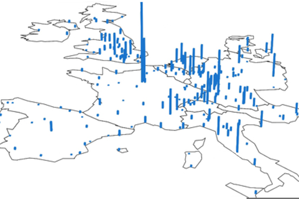Knowledge is a commodity


The map of ranks for cities in the selected European countries in 1990. Image courtesy of Qian Zhang.
When economists talk about producers and consumers—the people that make stuff and the people that use it—they’re usually thinking about commodities like coffee, wheat, or oil. Not knowledge.
That’s because knowledge hasn’t really been quantifiable before. But today, in this era of the “data deluge,” it is. For the first time in history, we can put numbers on what we know.
That’s what Northeastern Distinguished Professor of Physics, Computer Science, and Health Sciences Alessandro Vespignani and his team did in research published last week in the Journal Scientific Reports. They looked specifically at the “commodity” of physics and how it’s been passed around the world over the last fifty years.
First they assigned geographical locations to all of the papers published in the journals of the American Physical Society between 1960 and 2009, based on the affiliation of the authors. Papers written by Northeastern researchers would be tagged “Boston, Mass.” Papers written by Notre Dame authors would be tagged “South Bend, Indiana.” The effort took a good year to complete, and was mostly undertaken by the article’s first author, graduate student Qian Zhang.
The authors used this “geolocalization data” to understand not just the raw number of papers published in each place, but rather the number of citations to those papers exchanged among locations. They call these citations “the currency of the knowledge exchange.” Like dollars and euros, they are a proxy for knowledge production or consumption, depending on whether the final balance is positive or negative.
While the APS journals are based in the US, only 43 percent of the total publications came from US authors, but the trend was not static across the 50 years they looked at. In the sixties 86 percent were American, in the last ten years it’s down’ to about 37 percent. The team focused their analysis of all this data on the last twenty years, when the national representation among the APS journals was representative of physics around the world.
They found that while New York City was number two in physics production in the 1990s, it’s not even on the map today. Twenty years ago the east and west coasts of the US produced the majority of the nation’s physics knowledge, but today it’s scattered across the country.
Whereas two decades ago Europe was more of a consumer of physics, it’s become a major producer. And whereas China was absent from the physics conversation twenty years ago, it’s the leading consumer today. That’s because they are churning out papers faster than you can say “particle accelerator” and are citing boatloads of previous work in the process.
This gets to an important distinction, Nicola Perra, one of the authors, told me. Publishing lots of articles doesn’t make a country a top-ranking physics producer. That production needs to be valuable. It’s deemed such by other researchers who cite the work in their own papers. “Considering just the number of articles is not the real indication of position or importance,” he said. “You need to consider the entire system.”





